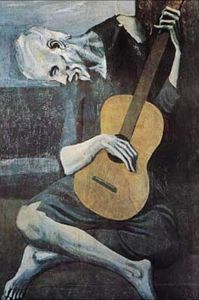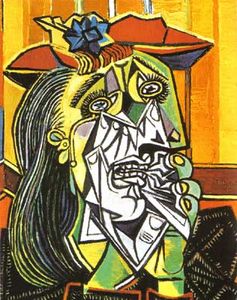Category: Arts + Media
Inside the mind of creative geniuses
Creative artists not only experience the world differently they also view the world differently. Picasso and Kandinsky, two of the well known creative geniuses of our time, both had disorders that forced them to perceive their world differently: could these disorders be one of the underlying factors that facilitated their genius?
Strabismus & Picasso
Stereopsis, the ability to have depth perception, is important for artists in order for them to paint the three-dimensional world realistically but new studies have shown that possibly many great artists did not have depth perception. Pablo Picasso, one of the many artists who had strabismus – abnormal alignment of the eyes – was able to create amazing pieces of art despite his inability to perceive depth. For him, this disorder made it easier for him to reproduce his two-dimensional representation of his subject matter. Margaret S. Livingstone and Bevil R. Conway state that “someone who cannot perceive depth from stereopsis may be more aware of—and therefore better able to capture—the other, monocular, cues to depth and distance, such as perspective, shading, and occlusion.” This can be seen in the painting on the left, Picasso’s The Old Guitarist where his shading skill and lack of depth perception is apparent. Picasso, is largely known for his cubist pieces, it is evident that going the route to cubism was ideal for his skill set due to his disorder.


Insights from a Failing Brain
For years, scientists have investigated cases of human brain damage as a means of further understanding the function of specific neural regions, but neuroanatomist, Dr. Jill Bolte Taylor, received the unique opportunity of experiencing this function-impeding damage firsthand. She awoke one morning to find herself having a stroke, and years later has recovered to share the event. Taylor’s unique experience sheds and interesting light on the underlying processes of our fascinating brains. Here is the video (via YouTube):
Sources:
Video Link - Ted.com
Background - DrJillTaylor.com
A Knitted Brain
Art is popular. There are many people that enjoy, support, or make a living off of art. It has the power to evoke emotion and also to allow one to express emotion through shapes, color, and patterns. Brains are popular too, but in a different sense. Everyone has a brain. Some may use it more than others, but it is something that all humans possess. This is, of course, excluding the various other life forms on earth that make use of a brain. What is not so popular is brain art. Especially brain art that is anatomically correct. The Museum of Scientifically Accurate Fabric Brain Art claims to be the largest collection of anatomically accurate representations of the brain made entirely from fabric. How exciting! The inspiration for each piece comes from dissections of the brain, functional magnetic resonance imaging (fMRI), neuroscience research, and positron emission tomography or PET (another medical imaging technique). These self-deemed "neuroartists" employ traditional art techniques such as quilting, knitting, and rug hooking to create their cranial masterpieces. Although extremely talented, these artists do warn not to use the accuracy of their art as a guide for any kind of surgical medical endeavor. More
The Trust Molecule
Paul Zak, the director of The Center for Neuroeconomic Studies at the Claremont Graduate University, for years has been searching for what makes us moral, and he thinks he has the answer. In this short talk Zak explains why massage, dance and prayer may increase donation to charity up to 50%, and how morals from a Californian high schooler to a primative Papua New Guinea subsistence farmer may have an identical physiological basis. The answer he claims, is Oxytocin. Here is the talk (via Youtube):
Trust, morality -- and oxytocin - Ted.com
A Brain Constructed from an Artist's Mind
Artist Yaron Steinburg's installation piece for any brain-lover is a masterpiece. This piece is not only stunningly beautiful but also thought provoking. At first glance, it may look merely like brain model made out of cardboard boxes. After taking a deeper look inside, however, a myriad of complex ideas can be observed. The complexity of the piece is deceptively hidden within the brain itself, wherein a booming city lies. The city looks like a seemingly unorganized mess, much like the many interacting regions of the human brain itself. The true brilliance of the piece though lies in looking past this cluttered city, and viewing the piece (and its message about the nature of the brain) for what it really is: an organized mess of infinite complexity and beauty.
Le Horla
This semester I decided it was a good idea to take up French again. So I signed up for “LF 303,” which is now where I sit for fifty minutes every Monday, Wednesday and Friday trying to convince my professor (and myself) that I am a halfway-competent French speaker. Which, it turns out, I could be. I have a feeling it won’t be long before I start dreaming in French again, at which point I’m sure I will have something neuroscience-related to say about that. 
That hasn’t happened yet, but French class has actually had some direct mind and brain content. Last month we read a short story called “Le Horla” by Guy de Maupassant. The story is written from the perspective of Dr. Marrande, a psychiatrist who comes across an interesting case and calls on some of his colleagues for their opinions. Dr. Marrande introduces his coworkers to the patient (referred to as such - “le malade”), and he lets the patient tell his own story. More
Dr. Jekyll or Mr. Hyde?

Have you ever wondered what pushes normal people to become hellacious monsters? Have you ever considered that the same person that turns evil has an equal chance of becoming a hero? If any of these questions have ever crossed your mind, Dr. Philip Zimbardo may have answers for you. More
Music Makes the Brain Grow Stronger
A recent study found that musical aptitude seems to have a relationship with reading ability. This study directly relates literacy with inherent musical aptitude that the researchers are able to measure, which is something that you're born with and that does not magically appear by listening to classical music on repeat. While they do examine the inherent musical aptitude, the study suggests that we might be able to prescribe some sort of musical curriculum that could potentially improve literacy in children. So, yes, all those weird to-be-moms holding heavy duty headphones up to their baby bumps blasting Mozart may be on to something. More
Scratching that "Cognitive Itch"
What comes to mind when you think of Friday? Friends. A night off from work. Movies. Fun. Rebecca Black? Yikes. I don’t mean to remind you of such a low point in the history of American pop-culture but there is, in fact, a small amount of useful information to be extracted from the phenomenon that is Rebecca Black. Why did her music spread like an epidemic through the minds of millions of teens and adults worldwide? This event can be loosely related to what the Germans like to call an öhrwurm.
The term öhrwurm literally translates in English to "earworm", and can be described as that inescapable occurrence of getting a song stuck in your head for an hour, a day, or even months at a time. The term is misleading in that the repetition of music does not occur in the ear but within the brain. For an experience that is so familiar to most people there is still much unknown as to how and why one contracts this stuck song syndrome. More
Esref Armağan
Most would agree that the most important of our basic senses is sight. Without it, many basic forms of communication fall apart, the vibrance of the world around us dulls, and our understanding and ability to sense the complexity of the physical world diminishes. Without the ability to see, it would logically be impossible to portray our surroundings artistically in a coherent and visually realistic manner...
...wait...what? More